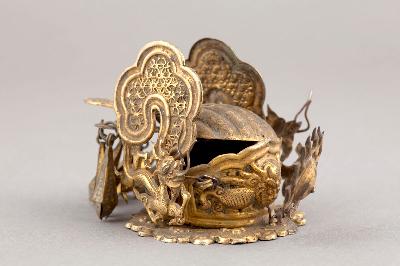Cap: Tubeteika
Production date
1970s
Description
One green silk tubeteika (in Uzbek called a duppi or kalpoq) - a round, slightly pointed skull-cap from Uzbekistan, quilted and embroidered in cream, black and crimson with an edging of black velvet; lined with crimson cotton. Owned and habitually worn by Rewi Alley in the last decade or so of his life.
See full details
Object Detail
Most often, black sateen or velvet are chosen for men's caps. Women's caps are made of silk, velvet, and brocade. They can have high or low border; can be trimmed with one-colour or multicoloured edging made of other fabrics; they can be embroidered in silk, decorated with beadwork, gold and silver threads and metal patch pieces.
Diversity of shapes and texture of tubeteikas is amazing. They can also be differentiated depending on the end-user: a man, a woman, a child or an old man. This difference can seem insignificant to an outsider, but an expert can clearly see whom it is intended for and he can never permit himself to put on an 'improper' cap.
Most widespread man's tubeteika from Chust in Ferghana Valley, for example, has a conventional, unpretentious, still rather decorative form. Contrast combination of four white pattern in shape of a capsicum (called 'qalampur') against black background is typical of tubeteikas from Chust. Hence, the four flowers on the top of a tubeteika, are supposed to protect a man's health from four sides, while sixteen small patterned arches, located along the edge of the cap, mean a wish to have a big and friendly family and sixteen children. Without such a tubeteika no man can appear in mosque as well as visit a wedding or funeral.
Tubeteikas vary from region to region. There are six historically formed regional groups, including the Fergana-Chust group, and those of Tashkent, Samarkand, Bukhara, Kashkadarya, Surkhandarya, and Khorezm. In each district there has developed its own style, passed over from generation to generation, from mother to daughter. Every woman enriches the traditional ornamental motifs with her own creative images. The ornament of embroidered articles has been formed gradually - from ritual magic patterns to poetic images, and is distinguished by variety of forms and high level of stylization.
The works of local masters are full of symbols. In composition of many works there prevail images of bushes in blossom, circles, rosettes, flower heads on thin stems, sprouts with leaves. Images of animals and bright plumaged birds are sometimes entwined in vegetable patterns. As a rule there are depicted the images of those plants which are believed to possess healing properties. 'Duppi' tubeteikas are embroidered in silk: in satin-stitch, in creed-stitch 'iroki', in special stitch named 'basma', and are decorated with beadwork. Experienced seamstresses arrange the patterns directly during the process of embroidering with no prior outlining.
'Gilam-duppi' tubeteika from Shakhrisabz and 'piltaduzi' from Surkhandarya, embroidered in creed stitch 'iroki', are distinguished for their picturesque multicoloured patterns. Young Uzbek women often complete their modern costumes with a bright elegant scull-cap. In Tashkent the most popular man's skull-caps are 'shobpush' tubeteikas, made of cotton fabric with lining, quilted manually or on sewing-machine.
The most peculiar is the gold embroidered skull-cap from Bukhara region. It's shape is usually round or tetrahedral, with vegetable or geometrical ornaments, decorated with a fringe and elegant tassels. Gold embroidery makes this scull-cap look brilliant and festive. That is why these skull-caps used to be an essential part of the emir's attire as well as that of the nobility. Nowadays such a tubeteika is an important element of a wedding costume. It is curious that as late as the beginning of the 20th century gold embroidery was exclusively man's trade, but in the later period women began getting involved in this craft more and more.
Uzbek skull-cap is justly considered to be one of the national types of applied art, an integral part of folk costume. The art of embroidery achieved its prosperity in late- 19th and mid- 20th centuries, when skull-caps got high popularity in everyday life of Uzbek people and were manufactured everywhere - in big industrial centres and in small villages. Mastership of tubeteika-making that have followed a long period of development of people's craftsmanship is full of deep emotional essence, love for ornamental images, high artistic culture.
Uzbek skull-caps are well-known worldwide. Being created by skilful craftswomen they decorate expositions of many museums. The best and most complete collections of skull-caps can be found in Tashkent museums, whereas among the people there still exists an old saying that "man's honour and morality lies in his skull-cap".
Part of 1 highlight set
Share
Comments
Can you add to our information about this item? Click Add Comment to share your knowledge and help enrich our collection. Have a question about this item? Please email info@canterburymuseum.com.
Be the first to comment.
To order a copy of this image please contact Canterbury Museum images@canterburymuseum.com
Unless otherwise stated, or an author is acknowledged, Canterbury Museum holds copyright to all information on Collections Online. All efforts have been made to trace copyright holders. Please contact the Museum with any queries on this matter info@canterburymuseum.com
The information on this page was created from historic documentation and may not reflect the best available knowledge about the item. If you have information or questions about the objects on this website, please contact us. Images may be subject to copyright laws and are therefore not of reproduction quality.



